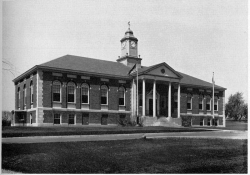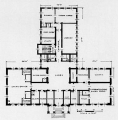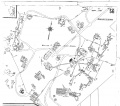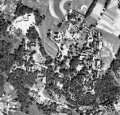Fernald State School
| Fernald State School | |
|---|---|
 | |
| Construction Began | 1848 |
| Opened | 1848 (Original location)/1887 |
| Closed | November 2014 |
| Current Status | Closed |
| Building Style | Cottage Plan |
| Architect(s) | William G. Preston, Clarence P. Hoyt |
| Architecture Style | Queen Anne & Romanesque Revival |
| Alternate Names |
|
Contents
History
Social reformer Samuel Gridley Howe founded the school in 1848 with a $2,500 appropriation from the Legislature. Records of Dr. Howe and the beginnings of mental retardation services in the United States reside in Fernald’s Howe Library. Under its first resident superintendent, Walter E. Fernald (1887-1924), the school became a model educational facility in the field of mental retardation. In 1925, the Legislature passed a bill officially naming the school the Walter E. Fernald State School. In it's later years it became involved with various experiments that came to light in the 1990's where doctors at the hospital were conducting radiation experiments on the patients living there. It is slowly closing due to an ever decreasing patient population.
The Walter E. Fernald State School, the oldest institution for the retarded in the country, began operation in Massachusetts in 1848 as the Experimental School for Teaching and Training Idiotic Children.
Prior to the establishment of the school, the governor had appointed three Commissioners of Idiocy to inquire on the "condition of idiots in the commonwealth and if anything can be done for them" (Resolves 1846, c 117). The commission's report, written by Samuel G. Howe of the Perkins Institution and Massachusetts Asylum for the Blind led to an experimental school being funded for three years by the state (Resolves 1848, c 65) and administered by the trustees of the Perkins Institution. The legislature incorporated it as the Massachusetts School for Idiotic and Feeble-Minded? Youth in 1850 (St 1850, c 150).
Resolves 1855, c 58 appropriated funds for a permanent facility, a site for which was found in South Boston. From 1863 the school was under the supervision successively of the Board of State Charities (1863-1879), the State Board of Health, Lunacy, and Charity (1879-1886), and the State Board of Lunacy and Charity (1886-1898), to whom it made quarterly census reports. By St 1898, c 433, s 9 it was placed within the jurisdiction of the State Board of Insanity.
The name of the school was changed to the Massachusetts School for the Feeble- Minded by St 1883, c 239, which provided that pupils were to be supported by quarterly payments from their place of settlement (in turn reimbursed by the state), expenses of those who had no place of settlement were to be paid by the state, commitments were to be made through probate or municipal court, trustees could receive or discharge students at their discretion, and that there be established as a separate department of the school an asylum for those who were beyond school age or not capable of being helped by the school's instruction. St 1886, c 298 further provided that indigent persons designated by the governor and special pupils from other states could be received, persons applying for the commitment of others must first notify the appropriate mayor or selectmen, trustees were to make an annual report to the state Board of Education, and the State Board of Lunacy and Charity could transfer a person from one of its institutions to the school.
By 1887 the school needed to expand and consequently Resolves 1887, c 64 and Resolves 1888, c 82 provided funds for the construction of a facility in Waltham. Occupation of the Waltham site began in 1890 and the South Boston facility was closed in 1892. Throughout the 1890s the legislature continued to appropriate money for the purchase of land surrounding the school and the construction of additional buildings.
To counter problems with students sent by their communities who were either delinquent, violent, or insane, St 1906, c 309 provided that anyone incapable of further instruction at the school could be sent to another institution if adjudged other than feeble-minded by the courts. St 1906, c 508 increased the number of trustees appointed by the governor to seven, two of whom could be women, and the trustees were to appoint a superintendent who was to be a medical doctor and to reside at the school and also assistant physicians, one of whom was required to be a woman. The trustees were to visit the school at least once a month and report on conditions there.
The responsibility for supporting the students at the school was removed from the communities in 1908, with the Commonwealth being liable for their board, care, and treatment (St 1908, c 629). In 1909 a recodification of laws relating to insane persons provided for twelve trustees for the school, six of whom were to be appointed by the governor. It also allowed for voluntary admission on application by a parent or guardian with medical certification, in addition to customary commitment by the courts (St 1909, c 504, ss 59-65).
Early in 1915 the State Board of Insanity urged the school to start outpatient work, which in fact it had already begun. Clinics were started in Worcester, Fall River, and Haverhill, with the hope that the advice and help given in the communities through these clinics would save the Commonwealth some of the expense of institutional care. By 1921 the school was one of several state institutions operating traveling clinics to diagnose children in accordance with the provisions of St 1919, c 277, which required school committees to provide special education to mentally retarded pupils within the public school system.
On the abolition of the State Board of Insanity in 1916, the Massachusetts School for the Feeble-Minded? came successively under the jurisdiction of the Commission on Mental Diseases (St 1916, c 285), the Department of Mental Diseases (St 1919, c 350, ss 79-80), and the Department of Mental Health (St 1938, c 486). In 1925, a year after the death of long-time superintendent Walter E. Fernald, the legislature renamed the institution the Walter E. Fernald State School (St 1925, c 293).
The 1960s brought two changes of note the school. In 1963 a work program was established (St 1963, c 394) in which certain students, known as patient trainees, were chosen at the discretion of the superintendent and paid for work performed at the school. In 1966 legislation provided for a comprehensive program of mental health and mental retardation services (St 1966, c 735) under the Department of Mental Health. Section 14 of the act stated that trustees of the Fernald School and those of similar state institutions were to establish and maintain, subject to appropriation, research and demonstration projects in vocational rehabilitation in cooperation with the federal vocational rehabilitation program.
One result of federal-state cooperation was the creation of the Eunice Kennedy Shriver Center at the Fernald School. The Shriver Center was built with matching state and federal funds as detailed in Public Law 88-164. The Shriver Center includes a Community Evaluation and Rehabilitation Center, which provides training for people working with the retarded, in areas such as biochemistry, genetics, and occupational therapy, and is associated with several local institutions of higher education. There is also a Research and Special Services Building, which was one of twelve research centers created in the nation by PL 88-164. The research building, in addition to its research activities, has been designated as a state-wide resource for the retarded.
The mental health and mental retardation services in Massachusetts were reorganized in 1986. A Department of Mental Retardation was created (St 1986, c 599), which supervises and controls all public facilities for the retarded including the Fernald School and is currently under the jurisdiction of the Executive Office of Human Services.[1]
As of November 29, 2014, the facility has been closed. The state sold the property to the city of Waltham in 2014 for $3.7 million, retaining some rights to profit from future leases and with some historical preservation conditions. As of 2020, despite considering use of the property as a high school or police station, it remains vacant.
Christmas in Purgatory
It has been speculated that this school was one of the schools showcased in the expose book Christmas in Purgatory by Burton Blatt and Fred Kaplan. Burton Blatt never publicly announced what the other four schools in the book were. He said that he would rather the pictures in the book be looked as current conditions in every state school instead of a select few in the North East.
Images of Fernald State School
Main Image Gallery: Fernald State Hospital
Books
- The State Boys Rebellion, by Michael D'Antonio
Videos
- The following is a twenty-six minute video on the The State Boys Rebellion, a book by Michael D'Antonio.
- This is a fifty-two minute documentary entitled "My Uncle Joe" which is about the narrator's uncle Joe who had spent most of his life in Fernald State School and his stories from that institution.
References
- ↑ From the state archives





